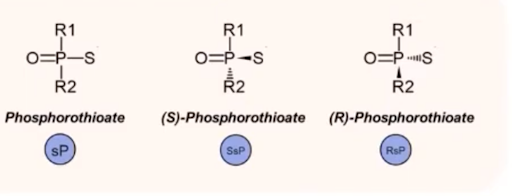RNA therapeutics have huge potential. As one group of researchers noted in the Frontiers in Bioengineering and Biotechnology, “RNA therapeutics comprise a rapidly expanding category of drugs that will speed solutions to the clinic; will actualize personalized medicine; and will make the term ‘undruggable’ obsolete.” But, as discussed below, the novel methodologies used to create these therapies present unique R&D challenges.
RNA Modifications Optimize Impact
RNA therapeutics can reach targets beyond those accessible to small molecule drugs because instead of blocking protein active sites, they disrupt the biological pathways involved in protein production. There are a variety of different types of RNA therapeutics, like antisense oligonucleotides (ASO), small interfering RNA (siRNA), mRNA vaccines, and various types of conjugates. While these diverse RNA types affect protein production in different ways, they have one thing in common—they frequently need chemical modification or specialized delivery systems to overcome inherent challenges with their efficacy, metabolism, and pharmacokinetics that arise due to factors like poor cellular update, high nuclease degradation, and low binding affinity for complementary sequences.
Non-Natural Residues/Monomers
To overcome limitations seen with “naked” RNA, researchers can modify RNA structures in a variety of ways, including chemical modifications to backbones, ribose sugars, and base analogs, as well as other structural modifications like nucleic acid bridging and chemical conjugation.
One common backbone modification approach, particularly in ASO design, is the incorporation of phosphorothioate linkages, in which one of the non-bridging oxygen atoms of the internucleotide phosphate group is replaced with sulfur. This modification can help produce nuclease resistance and increase protein binding in order to improve the pharmacokinetic profile of a candidate. The introduction of the sulfur atom results in the generation of a chiral center at each modified phosphorus atom, with two possible stereoisomeric forms, as shown in Figure 1. While studies show that chirally-pure phosphorothioate ASOs can be successfully synthesized, it is important to note that stereochemistry affects the pharmacological properties of the ASO. Therefore, it is imperative that researchers accurately capture different stereo forms.
Figure 1: Capturing details of chemical modification is important because those details can impact how candidates behave. For example, in the phosphorothioate ASOs shown here, stereochemistry is known to affect pharmacological properties.

As this example shows, there is a great deal of scientific innovation around the design and use of chemical modifications. Robustly capturing and registering structural-modification definitions, and where and how they’re used, is critically important so that R&D teams can properly define and protect their intellectual property (IP).
RNA Modifications Bring New R&D Challenges
Undoubtedly, RNA therapies represent the incredible possibilities of merging the worlds of biology and chemistry. But what does this mean for researchers? It means chemists and biologists need to work together collaboratively to design RNA-based entities. Software solutions for data capture, management and analysis need to be nimble to handle new unique entity types. Entities must be represented as both a chemical structure and as a biological sequence. These things may not seem like a big ask; but, for biology and chemistry research teams who have traditionally worked in silos with specialty tools, workflows, and R&D data that don’t easily mesh, these can be major hurdles that can slow work and impede innovation.
As most researchers can attest, most scientific informatics products were built to support chemistry or biology, but not both. As a result, cross-functional teams working on RNA therapies often face a difficult choice -— employ two separate systems to capture, manage and analyze chemistry and biology data, or choose one system that only properly supports either chemistry or biology.
Consequences of a Non-Cross-Functional RNA R&D Solution
The lack of a truly cross-functional informatics solution can lead to a number of challenges for teams working collaboratively on chemically-modified biologies like RNA therapies. Without a cross-functional solution, teams may face:
Multiple sources of truth for the same therapeutic entity, stemming from distinct chemistry and biology representations in two different systems
An inexact truth, as a result of using a biological registration system that fails to capture full details of complex chemical modification, such as non-natural residues common in RNA therapeutic entities
Slow processes and cumbersome collaboration that undermines scientific rigor
Weakened IP protection (for example, biological registration that fails to capture full details of entities)
Dotmatics is here to help with a united cross-functional informatics solution that supports both chemists and biologists, who typically have unique ways of thinking and working, even when collaborating on the same project.
Dotmatics Cross-Functional RNA Discovery Solution
At Dotmatics, we know that successfully developing RNA-based therapeutic candidates requires a complex interplay of chemistry and biology. So we have created the cross-functional Dotmatics RNA Discovery Solution to support the highly collaborative R&D needed for RNA drug discovery. Built with the needs of both chemists and biologists in mind, our solution enables innovative RNA research programs like no other solution on the market today.
The Dotmatics RNA Discovery Solution delivers:
A single platform for chemistry and biology: The Dotmatics Platform inherently understands both chemistry and biology; biologists and chemists alike can capture data in a common data-management system, ensuring a complete single source of truth for candidate entities.
Customizable scientific search and dashboards: With Dotmatics, users can search or browse their single source of truth using biology, chemistry, or some combination of both; they can then view results in project dashboards configured to their preferences, whether that’s a biology-focused view, a chemistry-focused view, or some mashup that shows chemistry, biology, and even supplemental data, such as screening results or sequence alignments, all together in one view.
Flexible ELN: Dotmatics ELN optimizes data capture because it can be fine-tuned to both biology and chemistry workflows and user preferences. Users can record and register robust candidate profiles by tracking key information that then becomes searchable, such as candidate ID, name, creator, molecular weight, extinction coefficient, target, sequence level information (e.g., sugar/base, base sequence, RNA base analog, sugar pattern), structural information (e.g., HELM string, InChI key), associated conjugate chemicals or entities, batch and lineage information, associated inventory data, experimental and screening results (e.g.,IC-50 dose-response curves, ELISA assay results, off-target mapping, biomarker assessment), etcetera.
Chemically-modified entity registration: Dotmatics’s registration capabilities support full chemical representation of biological entities; it allows complete scientific representation of candidates and supports chemical-uniqueness checking and search using compound structure and InChI keys. Registration for oligonucleotides, for example, includes a record of monomers and chemicals as the smallest functional units. Enabling proper and thorough defining of chemically-modified candidates is a priority for Dotmatics. In fact, we have worked closely with the Pistoia Alliance as part of a project to standardize monomer definitions and define best practices.
Cross-domain assay and analysis support: Dotmatics supports cross-functional workflows and offers a robust range of capabilities and tools that support both biology and chemistry experiments, assays, and analyses, which aid in lead selection and prioritization, activity assessment, and efficacy and safety profiling.
Learn More
Contact us today to learn how Dotmatics cross-functional solutions can help in your pursuit of RNA therapeutics.




